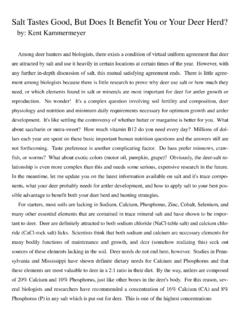Transcription of Purification of salt for chemical and human …
1 Purification of salt for chemical and human SWISS, Zurich, SwitzerlandThe presence of impurities in salt has serious economic and environmental increase the cost of brine treatment in chemical processes, magnify the problemsof contaminated effluent disposal and necessitate costly refining of salt for humanconsumption. The classic approach to salt Purification ranges from mechanical salt washingto vacuum salt Swiss has been engaged in developing unconventional and innovative processes thatare inexpensive, yet achieve highest levels of salt purity. This article examines the nature ofimpurities in salt and explains the unit operations employed in the Krebs Swiss SALEX saltpurification process.
2 It describes the prediction methods of the process performance andpresents results obtained in industrial plants commissioned recently. Finally, it describes thelatest developments in the production world-wideRecently, the annual world production of salt has reached 200 million tons. Approximatelyone third of the total is produced by solar evaporation of sea water or inland brines. Anotherthird is obtained by mining of rock salt deposits, both underground and on the surface. Thebalance is obtained as brines, mainly by solution mining. Brines can be used directly (forexample in diaphragm electrolysis) or thermally evaporated to produce vacuum typeWorld productionSolar salt70,000,000 t/yRock salt 60,000,000 t/yBrines 70,000,000 t/yThe purity of washed solar salt can reach 99 - (NaCl, dry bases) in India and Chinaand in Australia and Mexico.
3 The purity of processed rock salt fluctuates between97 and 99%+ in the USA and Europe. Vacuum salt is usually - consumption world-wideThe chemical industry is the largest salt consumer of salt using about 60% of the totalproduction. This industry converts the salt mainly into chlorine, caustic and soda ash withoutwhich petroleum refining, petrochemistry, organic synthesis, glass production, etc. would second largest user of salt is mankind itself. Humans need about 30% of the total saltproduced to support their physiological functions and eating habits. salt for food is the most"taken for granted" commodity, available from thousands of sources in hundreds of qualitiesas table, cooking and industrial salt for food Minerals, April 19961 About 10% of salt is needed for road deicing, water treatment, production of cooling brinesand many other, smaller userSalt consumptionChemical industry60%Food30%Other10%Whatever the use of salt , it is the sodium chloride in the salt that is required and not theimpurities.
4 The purer the salt , the more valuable it in natural saltsSodium chloride in salt is always the same. It is the "non- salt " in salt - the impurities - thatmake the difference. In fact, the multiplicity of impurities in salt , their relative quantities andhow they influence the salt properties are so variable, that every salt needs to be consideredon its own for insolubles, the origin of impurities is the sea water. Solar sea salts, as a rule justfew months old, are rather similar. Rock salts, millions of years old, may vary greatly, frompure to dirty, from white to black. Lake salts contain components leached from the ground ofthe surrounding rocks in variable quantities. salt lake chemistry is a science of its sulphate is the most persistent companion of salt .
5 In rock salt , calcium sulphate issometimes found as anhydrite, hemihydrite or polyhalite. Gypsum is found both in sea saltand in lake salt . Natural brines are, as a rule, saturated with calcium saltSea saltLake - 2% - 1% - 2% - - 1%TracesCaCl2 TracesNa2SO4 TracesKClTracesNaBrTracesInsolubles1 - 10% - 1%1 - 10%Magnesium salts are always present in the sea salt , usually in a ratio of approx. one and ahalf weight units of magnesium chloride to one weight unit of magnesium sulphate. In lakesalts, magnesium sulphate is usually accompanied by sodium sulphate, for example inRajasthan, India or in Azraq, Jordan. Magnesium chloride also occurs together with calciumchloride, for example in the Dead Sea where also potassium chloride and sodium bromideoccur in exceptionally high concentrations.
6 Insolubles are found in salts of all origins ingreatly fluctuating Minerals, April 19962 How do impurities in salt effect the chemical industry?In the chemical industry, salt is mostly dissolved together with the impurities in water orbrine. Prior to feeding the brine to the process, it is purified. Failure to purify the brineadequately may have serious, even lethal evolutionIn electrolytic cells, excessive magnesium will cause hydrogen evolution on the and chlorine form an explosive mixture. Explosion in the cells or in the chlorineliquefaction may damage the equipment and release chlorine to the environment. Chlorinegas is highly poisonous and dangerous. Stringent safety measures are taken in thechloralkali industry to avoid this to happen but the elimination of magnesium is of butterImpure brine in mercury cells will cause butter formation.
7 Butter will disturb mercury flow,causing short circuits that burn the electrodes. Alternatively, a large electrode gap must bemaintained which will increase the power consumption . Butter removal will expose workersto mercury vapours that are damaging to health. Disposal of mercury butter is costly andundesirable for the sludgeSludge from brine Purification in chloralkali plants with mercury cells is contaminated withmercury. Sludge decontamination by distillation requires high temperatures, is costly andnever complete. The disposal of mercury contaminated sludge is environmentallyobjectionable and very costly. Avoiding the formation of sludge is better than having todispose of it. This requires salt of high damageCalcium and magnesium will damage the ion exchange membranes irreversibly.
8 Erraticimpurity content in salt may cause hardness breakthrough to the membrane cost a fortune. The purer the salt , the more remote is the danger of soda ash production, excessive sulphate reduces the value of the product. Accumulatingcalcium in the process causes encrustation. Periodical scale removal is costly and leads toloss of may be a cheap commodity. But impurities in salt and their removal cost in many casesmore than the salt does the chemical industry deal with impurities in brine?In the chemical industry, impurities in brine such as calcium and magnesium are precipitatedwith chemicals. Sulphates are removed either by precipitation with barium or calcium or arecontrolled by purging the Minerals, April 19963 The main cost associated with brine Purification is the cost of chemicals and the investmentand operating cost of the brine treatment plant.
9 In mercury cell plants, the cost ofcontaminated sludge disposal and purge decontamination is also substantial. In themembrane cell plants, the loss of salt in purge is much higher than in the mercury cellplants, reaching 30% with a salt feedstock containing some of do impurities in salt mean to the food industry?Quality conscious consumers demand pure products. As one of the raw materials salt mustfulfil stringent specifications, otherwise the product quality may get salt , whether stored in silos or used in a shaker, must retain its free flowingproperties. Magnesium on the surface of the salt crystals absorbs humidity from the air andmakes the salt damp. Silos cannot be emptied and shaker holes get blocked.
10 The saltlooses market and salt refining: Vacuum crystallisationThe highest standards of quality are set by vacuum salt . Usually, vacuum salt is producedfrom brine obtained by cavity mining of underground deposits and chemically evaporating plants and their operation are costly and so is the vacuum salt . Sincevacuum salt is crystallized from brine containing up to 4% of sulphate, it always containssodium sulphate, frequently some 400 - 500 ppm or more. Despite the low calcium andmagnesium content in the 1 - 10 ppm range, vacuum salt will seldom exceed economical alternative: salt upgradingIf impurities are removed from salt directly, without dissolution and recrystallisation,substantial cost savings can result.


